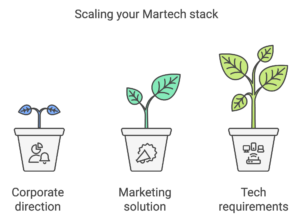Declutter your Martech for maximum impact with an annual audit
Martech can easily grow into a tangled web if left unchecked. It’s like a closet you keep stuffing with new clothes without ever cleaning it out. Over time, you lose sight of what you have, and suddenly you’re sifting through items you don’t need.
The annual Martech audit is the reset button, making sure your tech is driving real value and not taking up valuable digital space.
This yearly review clarifies which tools support your strategic goals and which ones are simply holding you back. Through regularly trimming and re-evaluating, you’re making future tech management easier, more cost-effective, and focused entirely on tools that push your business forward.
Systematically eliminate what’s not performing and optimize what is, and you’ll create a simplified, high-functioning tech ecosystem. The trick here is knowing what’s really driving your KPIs and what’s just noise.
Key takeaway: Keep it lean, keep it relevant—an annual audit is about getting the best results with the tools that fit best.
Align your Martech with big-picture goals
Your Martech setup should be a precise reflection of your business’s highest objectives. Whether you’re focusing on growth, stabilizing, or making operational cuts, your technology choices need to be fully in sync with these priorities.
Alignment is what takes your Martech from a collection of tools to becoming a living system, dynamically supporting your strategy.
Set Martech up to serve your business vision
Everything starts with your company’s purpose and trajectory. If growth is the target, let’s lean into tools that amplify reach, enable scaling, and attract new customers. But if stability is the aim, you might focus more on optimizing current assets and reducing unnecessary tools.
Being laser-focused on your strategic goals is what keeps your tech effective rather than bloated and wasteful.
Make your tech choices match your growth goals
When you’re ready to scale, make sure your Martech stack scales with you. Suppose expansion is on the agenda—dynamic pricing could become a game-changer. In this case, AI and machine learning are key for personalization, and a CRM system will let you smoothly manage customer data.
Each layer builds on the next, supporting and amplifying growth. Picture it like this:

Map the customer journey to pinpoint your Martech essentials
If you want technology that connects with your audience, you need to understand your customer journey. Tracking every step—from awareness to loyalty—let’s you spot which tech augments each stage.
The focus here is on aligning Martech directly with the experience you want to provide.
Mapping out these key moments, help you set up a tech stack that genuinely supports the customer’s path and helps identify tech gaps you need to fill.
Follow your customer’s path to fine-tune Martech needs
When you know exactly where customers engage and drop off, your tech stack gets a purpose. Maybe you’re missing a tool that strengthens engagement at a key decision point, or perhaps you can cut back on tools that don’t contribute to customer loyalty.
Keeping a clear eye on the journey lets you fine-tune each touchpoint with relevant, useful tech that keeps customers coming back.
Build better use cases with insights from every team
The best solutions don’t come from a single department—they’re built when marketing, tech, and business minds come together. Collaboration here brings in diverse perspectives and helps pinpoint real needs, as well as technical and operational impacts.
Quality input creates a more detailed, thoughtful use case library that can support everything from strategic planning to budgeting. It’s a bit like building the blueprint for a skyscraper—every team’s input improves stability and scale.
Roll out a strategy that sticks
Personalization is a powerful driver for better customer experience and increased revenue, but it’s not a quick fix. Done right, it’s transformational. But to make it work, you need a phased, strategic approach.
This typically involves setting up unified datasets, defining clear identity resolution practices, and focusing on data enrichment. All of these foundational steps pave the way for effective, actionable personalization.
Learn to leverage personalization (without the headaches)
Personalization is a must-have for creating a better customer experience and driving loyalty. The core challenge lies in the resources it requires.
Breaking down the project into manageable phases—like starting with unified datasets and layering in other aspects over time—makes sure that personalization adds genuine value without overwhelming your team.
4 personalization tips for big wins
- Get all your data working together: To personalize effectively, your data can’t be siloed. Building a unified dataset lets your entire Martech stack work off the same information, creating more seamless, personalized interactions.
- Make Martech tools talk to each other: Your Martech tools need to communicate effortlessly. Integration across tools within your stack makes sure data flows smoothly and that each tool complements the other.
- Set up smart triggers for personalized experiences: Defining triggers for personalization, such as location, behavior, or source of traffic, lets you deploy personalized content that’s relevant to each user’s unique situation.
- Manage pricing with data-powered personalization: Pricing models based on rich customer data let you respond dynamically to demand, competition, and user behavior. Personalizing pricing requires an agile tech setup that lets you experiment and adapt quickly.
Find gaps, drop duplicates, and keep what counts
Your Martech stack should work like a well-oiled machine, but that only happens if you keep a close eye on it. Identify gaps where new tools could help, and cut out duplicates that add no value.
This is the capsule wardrobe approach to Martech—only keeping what’s essential. The focus here is clear: reduce friction, eliminate redundancies, and keep every tool working hard for your goals.
It’s easy for tech to pile up in response to different needs, but there’s also a cost to having too much. Regularly evaluating which tools deliver and which don’t will help you keep only the ones that serve a clear purpose.
Use scoring models and demos to find Martech that delivers
Choosing the right Martech is easier with a scoring model that removes the guesswork. Weighing each tool by its impact, cost, and complexity lets you balance departmental needs with real insights.
Vendor demos and sandbox trials provide another layer, giving your team firsthand experience with potential tools and their fit with your unique needs.
Make Martech choices easier with a simple scoring model
An objective scoring model provides an unbiased way to judge each tool. Scoring by impact, cost, and complexity shines a light on where tools are delivering and where they aren’t—making sure legacy systems are carefully evaluated rather than automatically kept.
Test-drive Martech with demos and sandbox access
According to Forrester, 25% of organizations juggle 10 or more BI platforms, with 61% using four or more—clearly pointing out the need for smart choices in Martech.
Vendor demos that address specific use cases offer a practical look at a platform’s strengths and weaknesses. Sandbox access gives your team a chance to work hands-on, making it easier to decide if a platform is the right fit or just another potential redundancy.
Bring in fresh eyes for a balanced Martech review
Sometimes, a third-party viewpoint adds valuable perspective. Independent consultants bring that fresh take, with objective insight into your Martech evaluation. They can cut through internal biases and clarify the best solutions to match your corporate goals, ultimately giving you a balanced roadmap to guide your Martech strategy forward.
Final thoughts
Is your Martech stack propelling you forward, or is it quietly weighing you down? Every tool should either power your strategic goals or provide genuine customer value—anything else is excess.
Imagine what could happen if every piece of tech actively advanced your vision. Are you equipped to cut the clutter, focus on precision, and transform your Martech stack from a collection of tools into a streamlined, strategic machine?





